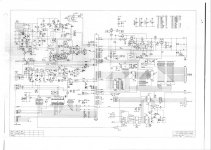Witchy
Experienced Member
Hi folks,
I have a UK rarity in a Tandata PA 'personal organiser' and viewdata terminal, the keyboard PCB of which has been eaten by battery leakage - it's lost several copper pads and some of the interlink traces have disappeared too. Deeming it too expensive to repair/replace I'm looking at an arduino replacement since it's a 12x12 passive matrix so there's no intelligence in there.
I've already drawn up the matrix and made up a little keyboard so I could use basic controls, cursor keys etc, and that works fine. I have an Arduino PS2 converter sketch that I can program to output either the PS2 key pressed or a code and I could easily wire up something like an Arduino Mega to control the 12x12 matrix, but how do I do this safely without possibly breaking the PA's motherboard or Arduino? The PA's PSU can easily run both and they're both 5V devices so there shouldn't be an overvoltage problem, I'm just exercising caution.
TIA!
I have a UK rarity in a Tandata PA 'personal organiser' and viewdata terminal, the keyboard PCB of which has been eaten by battery leakage - it's lost several copper pads and some of the interlink traces have disappeared too. Deeming it too expensive to repair/replace I'm looking at an arduino replacement since it's a 12x12 passive matrix so there's no intelligence in there.
I've already drawn up the matrix and made up a little keyboard so I could use basic controls, cursor keys etc, and that works fine. I have an Arduino PS2 converter sketch that I can program to output either the PS2 key pressed or a code and I could easily wire up something like an Arduino Mega to control the 12x12 matrix, but how do I do this safely without possibly breaking the PA's motherboard or Arduino? The PA's PSU can easily run both and they're both 5V devices so there shouldn't be an overvoltage problem, I'm just exercising caution.
TIA!

